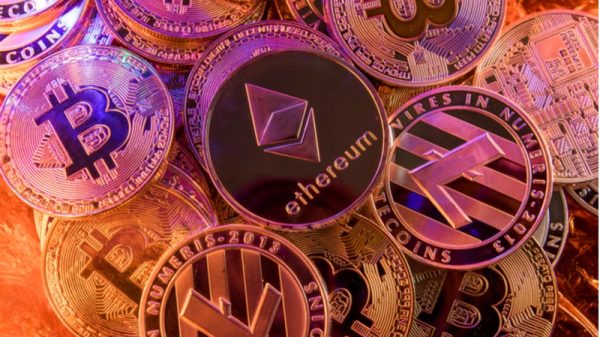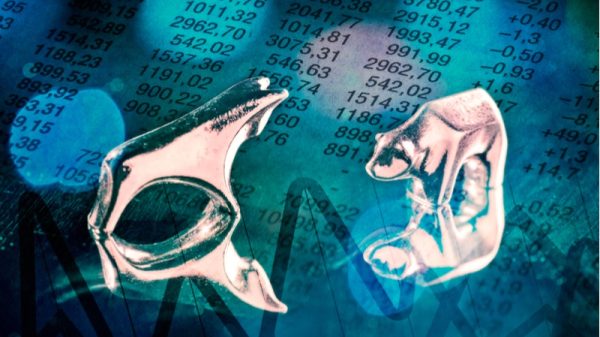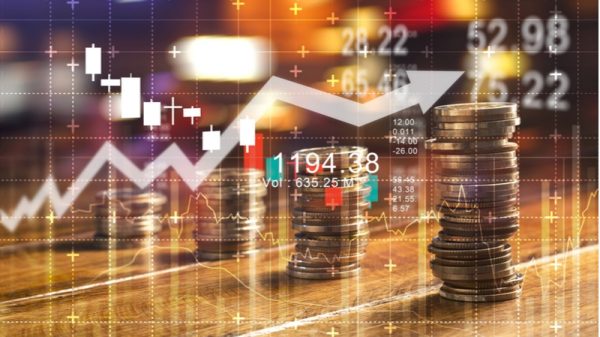Moderated by Thom Calandra of the Calandra Report, the precious metals panel at this year’s New Orleans Investment Conference featured several well-known gold analysts and market watchers.
Omar Ayales, Rich Checkan, Jeff Deist, Avi Gilburt and Dana Samuelson took the stage for a 35-minute discussion that began with a discussion of the monetary value of gold and Bitcoin, as well as the liquidity pros and cons of both.
For Deist, general counsel at Monetary Metals, it all comes down to a word he used frequently: “moneyness.”
“Gold still has a degree of moneyness. (But) gold isn’t money in the sense that you can’t use it at the street retail level anywhere in the world — there’s no demand for that,” he told the audience at the show.
“So when we talk about gold, or any other precious metal, it is a monetary asset. It has a degree of moneyness,” Deist went on to explain. “Bitcoin, I would argue, (also) has a degree of moneyness, treasuries have a degree of moneyness. And then there’s liquidity and a demand that may give them money-like properties.”
From there, Calandra offered an anecdote about the difficulties associated with selling physical gold, prompting Ayales, chief trading strategist at Gold Charts R Us, to highlight the ease of monetizing cryptocurrencies.
“Cryptos are so easily bought and sold, the platforms allow for that, (which) allows for the younger generation to be able to be more invested, whereas gold is a bit harder,” he said.
‘Unless you have a trading account, or you buy exchange-traded funds, or you have a coin dealer or somebody that you can buy directly from, it’s a little bit harder, especially if you want to sell.”
Reciprocal gold theory
Calandra then brought up reciprocal gold theory, which suggests that gold’s value is maintained through its relationship with currency and economic confidence, acting as a mirror reflecting the stability or instability of fiat money.
According to reciprocal gold theory, as trust in fiat currencies diminishes — often due to excessive debt, inflation or poor monetary policies — the value of gold tends to rise, making it a reciprocal measure of confidence in the financial system. Essentially, gold’s worth is inversely related to the perceived strength of paper money.
For Calandra, who believes in reciprocal gold theory, gold will eventually ‘pay back’ the gains seen in blue-chip stocks, like Fortune 1000 companies, noting that as stocks rise higher, gold remains undervalued.
He noted that when these stocks decline, or confidence in them wanes, people may shift investments into gold. With that in mind, he asked panelists when investors will raise their gold allocations from 1 percent to 2 to 3 percent.
For his part, Deist pointed out that North American investors have a different relationship with gold than investors in Turkey or India, where the average citizen owns more gold in the form of jewelry, dishware or physical coins.
Deist expects North American investors to bolster their gold holdings soon.
“I think we have to have a cultural shift where people under a certain age — as is happening right now — start to feel like some people in this room (felt) in the ’70s. You have a solid decade of seeing your paycheck and your savings eroded, and people are going to be looking for the exit,” he commented.
Building on Deist’s thoughts, Dana Samuelson, president of American Gold Exchange, highlighted the differences between these countries and the US. “The gold cultures around the world are in countries where there’s either been war on their shores, or their currencies failed. It’s as simple as that,” he said.
“We’ve never had either of those things happen, and until we do, I don’t think we’ll really have a true gold culture in the US on a very fundamental level, which almost every other country in the world has to some degree.”
Weighing in, Rich Checkan, president and COO of Asset Strategies International, explained that while the media celebrates stock market highs, these are only nominal gains in “worthless” US dollars.
In reality, when compared to gold, the market hasn’t reached true highs.
“You look at the S&P 500 (INDEXSP:.INX) … with reinvestment dividends, over this millennium, it’s up a little over 500 percent, gold’s up over 800 percent in the same time period,” said Checkan.
“If you measure the Dow Jones Industrial Average (INDEXDJX:.DJI) in gold, we’re not even to the point we were at during the.com bubble. The Dow is 60 percent of the way to the dot-com bubble. We’re not making new real highs.”
Paper silver and price performance
Turning the panel’s attention to silver, Calandra asked, “What, if anything, will ever be done about the massive short position in paper silver led by JPMorgan Chase (NYSE:JPM)?”
According to many silver market commentators and watchers, this short position in paper silver refers to large-scale bets against the metal’s price using financial derivatives rather than physical metal.
Critics argue that such positions can artificially influence silver prices by increasing selling pressure. While some suspect market manipulation, others see it as standard trading practice.
Responding to Calandra, Avi Gilburt, lead analyst and founder of Elliott Wave Trader, said he expects JPMorgan and other institutes to cover their shorts. “Historically, when you approach the end of the cycle, silver is what brings up the rear,” said Gilburt, referring to a “massive spike” in silver in 2011 at the end of that cycle.
Indeed, the white metal rose to an all-time high of US$48.12 per ounce in April 2011.
Later in the discussion, Gilburt explained that he uses the KISS — keep it simple, stupid — method for market analysis, noting that markets top when people get too bullish, and when they are too bearish markets bottom.
To know when the market is too bullish, Gilburt uses Fibonacci mathematics and Elliot Wave Trader “structures.”
“When sentiment has reached a peak in the metals, it’s often when you see that final parabolic rally, when silver is also rallying parabolically alongside gold,” he said. “That’s how we look at it; we try to keep it as simple as possible.”
Purchasing power
Anyone familiar with Calandra is likely aware that he often refers to the purchasing power of gold.
One way to measure this is via the gold/silver ratio. Calandra has also previously discussed how over the years an ounce of gold has consistently been the right price to buy a good-quality suit.
During the precious metals panel, Samuelson offered a different metric, the gold/oil ratio.
“One thing that’s come on my radar recently is the gold-to-oil ratio,’ he said.
‘If you go back to the ’80s, the gold-to-oil through 2008 was very consistently about eight to 10 parts oil equal to one part gold. And now that ratio has been up close to 40 to one.”
Deist also referenced purchasing power when discussing rising US debt and higher Treasury yields, suggesting that increasing interest payments could destabilize the US financially.
“Maybe gold is finally decoupling from all of these standard metrics we use, if we look at it only in terms of what it can buy, as opposed to looking at it nominally and looking at these parabolic rises,” he said. “Maybe the world is finally shrugging and saying the US dollar as the world’s reserve currency is an unsolvable problem.”
Deist went on to point to the paradox created by countries using the dollar as a reserve currency.
Countries need dollars for trade, so a dollar crash isn’t in their short-term interest. However, in the long term, there’s a desire for alternatives to the dollar due to US deficit spending and inflation.
“As long as we have this intractable problem, America will always spend in deficits. It’ll always export inflation, it’ll always use the dollar to try to enjoy a living standard it hasn’t earned,” said Deist.
Gold and silver price predictions
The panelists also offered their forecasts for where precious metals prices may go.
Moderator Calandra expects to see gold reach US$3,000 per ounce by the end of 2024.
Samuelson made a more conservative prediction, explaining that he sees gold in a consolidation phase, trading between US$2,650 and US$2,750 to end the year, depending on geopolitical events.
For 2025, he believes gold could reach US$3,500, while silver could hit US$40 to US$45 per ounce.
Gilburt anticipates one more push higher for gold before a multi-month consolidation. In his view, the yellow metal will then reach a level of US$3,300 to US$3,400 after the consolidation.
For Checkan, gold could rally to US$3,800 before the end of the current bull market, similar to previous bull cycles.
Ayales sees gold potentially reaching US$4,000 by 2025, based on a parabolic move comparable to the 2000 to 2011 period. Deist didn’t offer a prediction, but sees gold potentially benefiting from a west-to-east wealth shift.
Securities Disclosure: I, Georgia Williams, hold no direct investment interest in any company mentioned in this article.
























